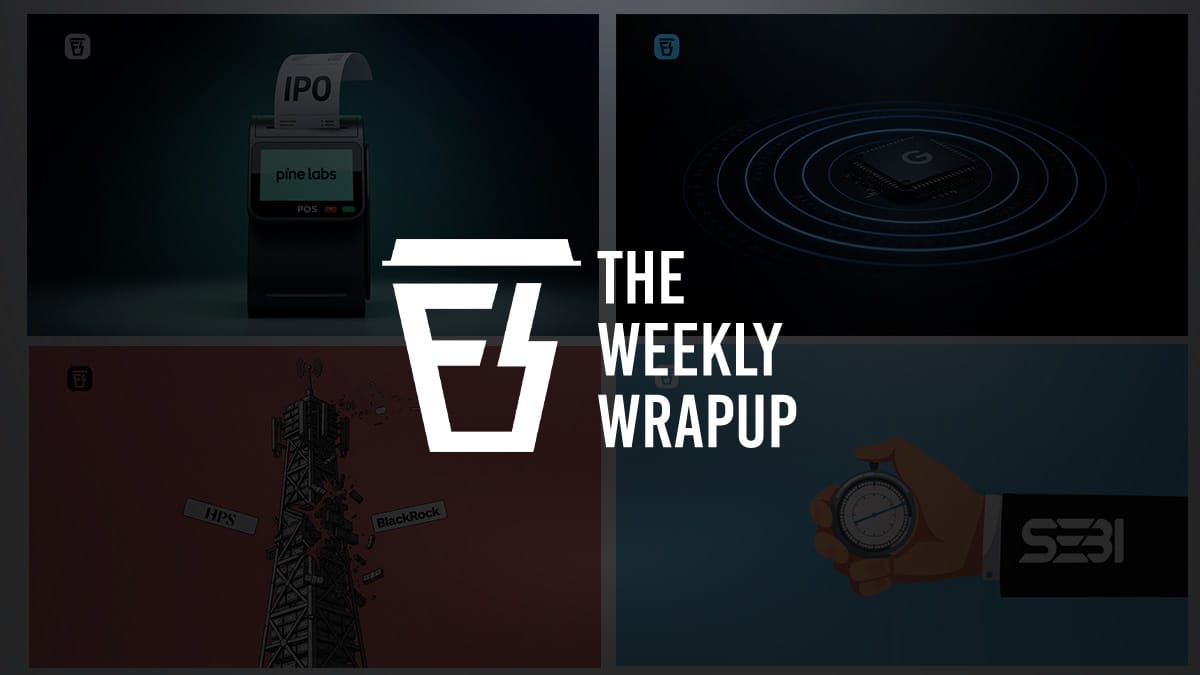Pine Labs IPO, SEBI’s T+0 delay, quantum computing and more…

In this week’s wrap-up, we broke down SEBI’s proposal to cut mutual fund expenses, explained how Groww’s IPO is riding India’s stock market wave, covered a $500 million fraud built on fake invoices and disappearing borrowers, explored Google’s new quantum leap and the cybersecurity risks that come with it, and decoded why SEBI’s T+0 excitement has quietly fizzled out.
And in this week’s Markets edition, we broke down the Pine Labs IPO — how a point-of-sale (POS) company has scaled impressively over the years, why it’s finally choosing to list, and what the numbers reveal about its growth story. Click here to read the full markets story.
Also, here's a quick announcement before we begin – Finshots Idea Lab is back!
After the massive love and excitement of Season 1 of our national-level case competition, we’re back with an even bigger challenge! Compete in 3 rounds to solve real-world business problems and receive cash prizes worth ₹2.25 lakh, exclusive goodies and a lot more!

Know more about the competition and apply here.
And with that out of the way, let’s take a look back at what we wrote this week.
Why mutual funds will soon cost less
For over a decade, mutual funds have been the go-to for Indian investors. With ₹75 lakh crore in assets and 25 crore accounts, it’s a massive industry. But that scale has also brought complex charges and hidden costs that few investors truly understand.
So the market regulator, SEBI, now wants to change that. It’s proposed a new rulebook that simplifies how total expense ratios (TERs) are calculated and disclosed. From exit loads and brokerage caps to GST and transaction costs — everything will now show up in a transparent breakdown.
There’s even a proposal for performance-linked TERs, where funds that beat benchmarks can charge more, and those that underperform, charge less.
This could be a big deal. And for investors, it could mean fewer surprises and fairer fees. But for mutual funds, it may mean tighter margins and a rethink of how they structure costs.
You can read about it in our Monday story to know what this overhaul means for your SIPs and the industry at large.
The Groww IPO explained
Back in 2016, investing in India felt intimidating. Then came Groww, a discount broker with a clean interface, simple onboarding, and educational content that brought millions of first-time investors into the market.
Today, it has over 1.2 crore active NSE clients and ₹3,900 crore in revenue. And it’s now heading to the public markets with a ₹6,632 crore IPO.
But while the numbers are impressive, there’s nuance. Over 85% of revenue still comes from brokerage, making it vulnerable to trading slowdowns. And a look at the valuations say it’s priced a bit above peers like Motilal Oswal and Angel One.
So is this a growth story worth paying a premium for?
That’s what we unpacked in our Tuesday newsletter.
Bankim Brahmbhatt and the $500 million lesson in lending against thin air
Imagine lending $500 million to a telecom firm… only to realise the invoices backing it were fake, the customers didn’t exist, and the borrower had vanished.
That’s what happened to HPS Investment Partners, now under BlackRock, and potentially even BNP Paribas. The fraud was allegedly orchestrated by Bankim Brahmbhatt, whose companies secured loans against fabricated customer emails and forged documents.
It’s a classic case of asset-backed lending gone wrong. And it’s not because the structure failed, but because the “assets” never existed.
Our Wednesday story explains how even billion-dollar institutions can fall for smoke and mirrors, and why old-school due diligence still matters.
A breakthrough that might break the internet
Google just ran a simulation 13,000 times faster than the world’s best supercomputer using a quantum chip named Willow.
That sure sounds exciting, until you realise it could also break encryption!
Meaning, with enough power, quantum computers can crack the algorithms that keep your bank logins, emails, and digital signatures secure. And that’s why governments and companies are racing to develop “quantum-proof” encryption, even as quantum computing promises breakthroughs in medicine, materials, and artificial intelligence.
And our Thursday story explores both sides of this double-edged chip.
What happened to all the T+0 excitement?
About a year ago, SEBI’s T+0 dream promised lightning-fast same-day settlement of stock trades. A pilot was launched, deadlines were set, and the future looked imminent.
But now, the rollout has been indefinitely postponed.
The reason, as it turns out, is that most brokers aren’t ready. The tech upgrade is costly. The trading volumes are too thin. And even investors aren’t excited about paying extra per trade for instant settlement. Worse, global funds can’t easily meet pre-funded trade requirements due to time zone and currency hurdles.
All of this has made full T+0 adoption near impossible for now.
So until demand picks up, the feature that promised to speed up everything may just be stuck in neutral. But does that mean T+0 is dead?
That's what we answer in our Friday newsletter.
Liked this week’s wrap-up?
